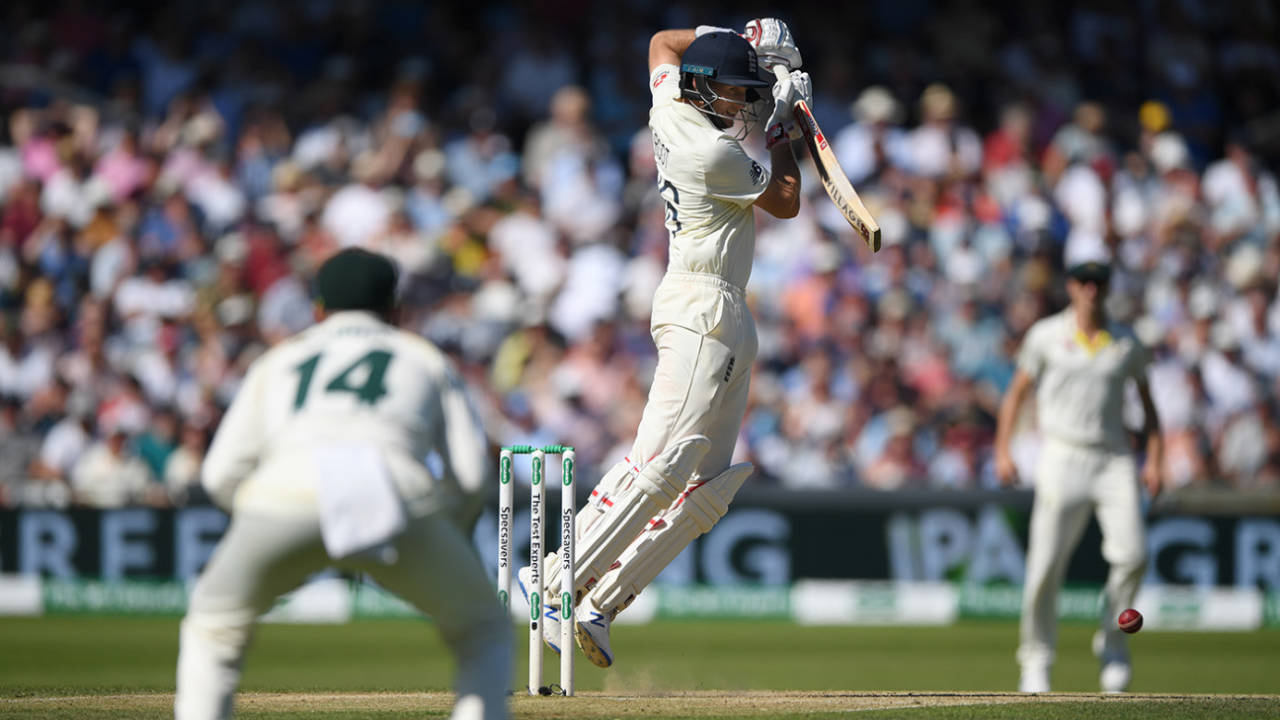Second innings a 'better template' for England's batting, admits Root
England proved they have it in them to bat properly in Test cricket, claims captain
George Dobell in Leeds
26-Aug-2019
Joe Root was watchful in his second-innings 77 • Getty Images
Joe Root has accepted England's second innings batting in Leeds provided a "better template" of the way they should go about things in the future.
England were bowled out for just 67 in the first innings in Leeds, their lowest Ashes total since 1948. But they showed far greater application in the second innings with Root, Joe Denly and Ben Stokes all building patient half-centuries - from 120, 134 and 152 balls respectively - enabling England to pull-off the highest successful run chase in their Test history on the fourth afternoon.
That left Root, who has generally been an advocate of the aggressive style of batting that has typified England's Test cricket in recent years, acknowledging his side had to learn to "give yourself a chance" with the bat if they were going to compete in such games.
ALSO READ: Dobell: Stokes asserts his greatness
"Let's talk about the first innings," Root said after England's series-levelling victory. "We were poor. We were very poor. Probably two guys can say they were got out.
"Of course it was bowler-friendly conditions and it did seam around a bit. But we weren't good enough. It's simple as that. Every single one of us in that dressing room knows that is not adequate for Test cricket.
"The way we approached that second innings was a better template for us, for sure. It comes down to the same things: you've got to give yourself a chance to get in. You've got to build partnerships. And when sides like Australia have a good seam attack and are backed up with a very good spinner, you have to take them deep. And that's what we did second time around."
England were helped, of course, by something of a miracle contribution from Stokes. But while Root accepted that innings was "ridiculous" and that England had some fortune with the conditions, which improved for batting, he also felt that his team adapted to the task they faced in the fourth innings.
"It's a lot easier to pick apart an innings like that when you've won rather than being out of the series," Root said. "And of course conditions did favour us slightly better. We knew at the toss - knowing the history of the ground and having played here a lot personally - that wickets tend to get better so we knew that was in our favour.
"But we learned extremely quickly. We knew we had to find a way to stay in the game as long as we could. We bounced back and proved we've got it in us to bat properly in Test cricket. Games like that make Test cricket the best."
The fourth Test begins in Manchester on September 4. There could well be changes to the side with James Anderson, if he is deemed fully fit, vying to replace Chris Woakes. That would weaken England's batting, however, and leave the prospect of a bottom four of Jofra Archer at No. 8, Stuart Broad at No. 9, Jack Leach at No. 10 and Anderson at No. 11.
As a result, there are sure to be discussions about the top-order batting, too. Jason Roy, averaging 9.50 across the first three Tests, looks especially vulnerable though Jos Buttler, with one Test century from 34 Tests and a series average of 9.16, is not as secure as he seemed a few weeks ago. The manner of his second innings dismissal - stranded when called for a run and then sent back by Stokes - may ensure he wins another opportunity. The likes of Dom Sibley, an opening batsman, and Ollie Pope, a middle-order batsman, are the men pushing for inclusion.
George Dobell is a senior correspondent at ESPNcricinfo
